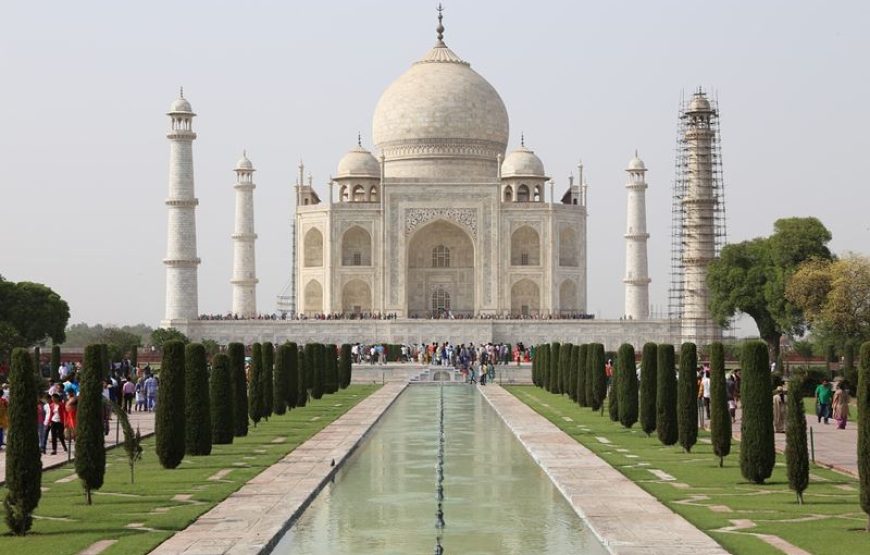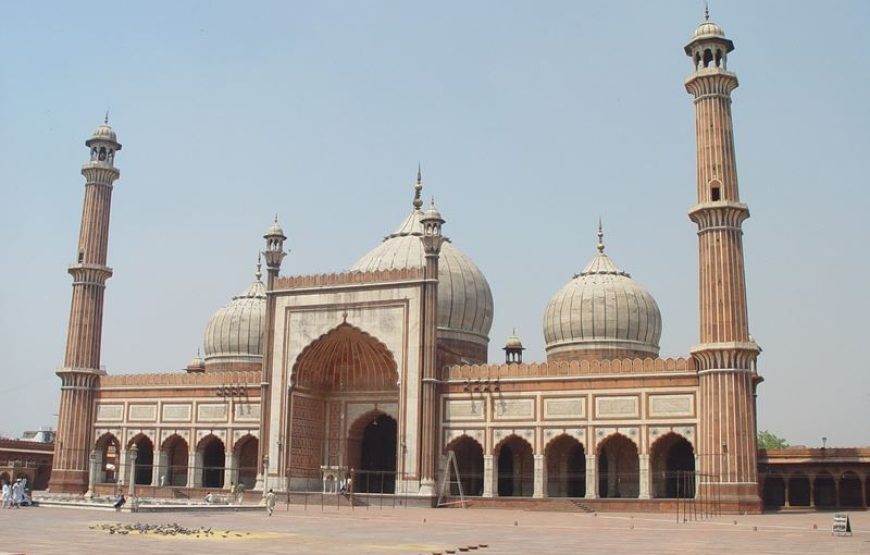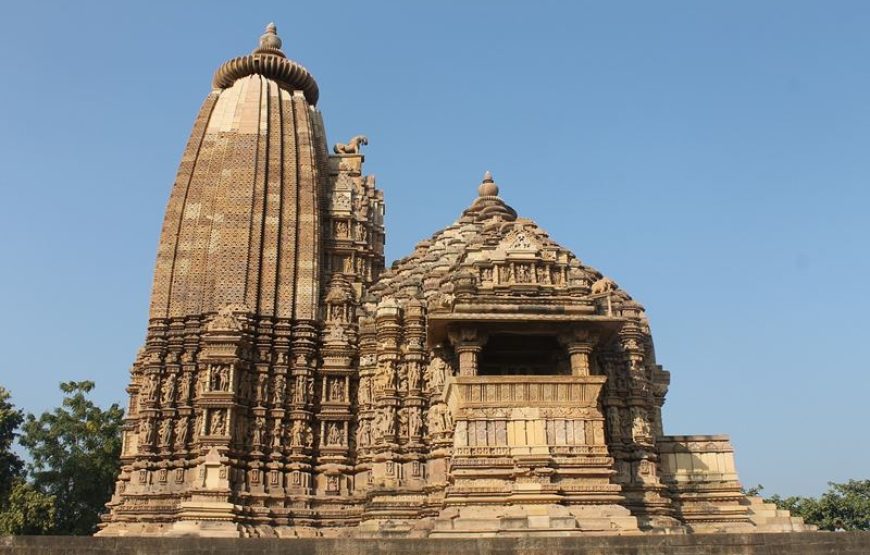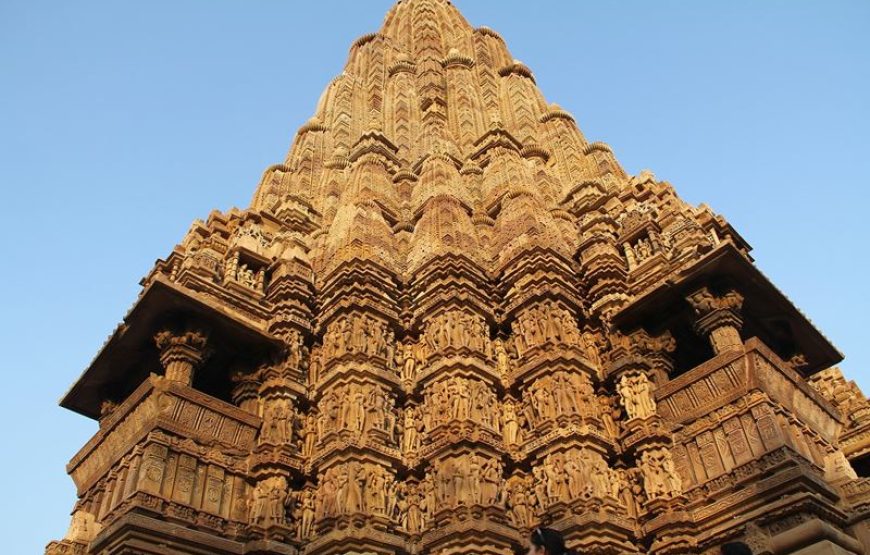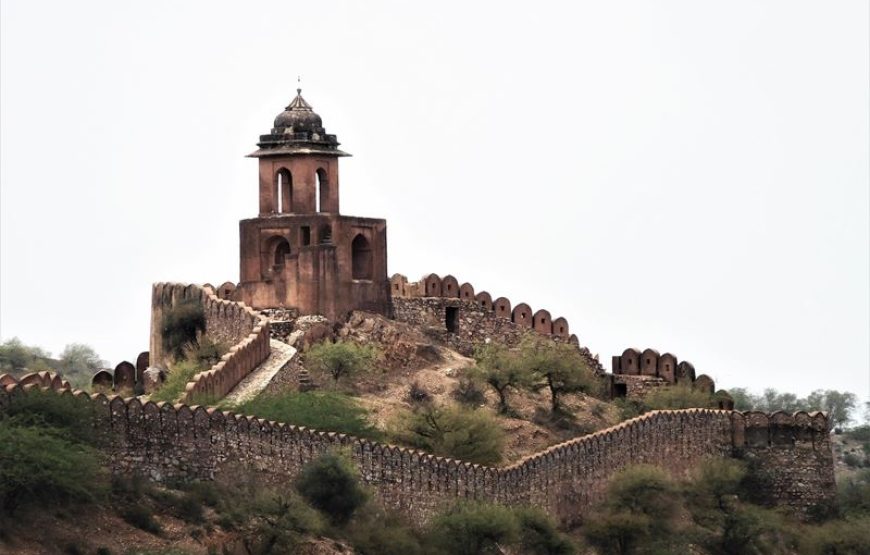DAY 01 –ARRIVE DELHI
Today arrive Delhi and transfer to your Hotel. India’s capital and a major gateway to the country, contemporary Delhi is a bustling metropolis, which successfully combines in its folds - the ancient with the modern. Amidst the fast spiralling skyscrapers the remnants of a bygone time in the form of its many monuments stand as silent reminders to the region’s ancient legacy. The first impressions for any visitor traveling in from the airport are of a spacious, garden city, tree-lined with a number of beautiful parks. Overnight at Hotel
DAY 02 – IN DELHI
After breakfast proceed for tour of Old and New Delhi. Old Delhi, the Mughal Capital of Shahjahanabad. Visit the Jama Masjid which is the principal mosque of Old Delhi in India. Commissioned by the Mughal Emperor Shah Jahan, builder of the Taj Mahal, and completed in the year 1656 AD, it is the largest and best-known mosque in India. It lies at the origin of a very busy central street of Old Delhi, the Chawri Bazar Road. The mosque of Friday was built from 1644 to 1658 during the reign of Shahjahan. The mosque is 80 m long and 27 m wide. The courtyard can accommodate 25,000 worshippers and occupies 408 square feet.
Later we proceed to visit Raj Ghat where Mahatma Gandhi – The Father of Nation, was cremated and drive past the Red Fort [ from outside] - the palace for Shahjahan’s new capital, Shahjahanabad, the seventh Muslim city in the Delhi site. Wander in the busy streets of the mile long Chandni Chowk, popularly called “The Silver Street”. Enjoy the ‘Cycle Rickshaw’ ride in Old Delhi.
In the afternoon proceed for tour of New Delhi, which reflects the legacy the British left behind. The division between New and Old Delhi is the division between the capitals of the British and the Mughals respectively. The division in the walled city and New Delhi also marks the division in the life-styles. The walled city is all tradition where one will be able to glean a past life-style in all its facets, colours and spells. New Delhi in contrast, is a city trying to live up to the best of 21st century standards.
The tour to Imperial Delhi will start by visit to the Qutab Minar, the tallest stone tower in India. The Qutab Minar was started in 1199 AD by Qutab-ud-Din Aibak and completed by the sultan's successor and son-in-law, Iltutmish. The building is 72.5 m high and has 379 steps from the bottom to the top. The Minar is tapering with the diameter of the base is 14.3 m while at the top floor it is 2.7 m. The Qutab Minar is still the highest stone tower as well as one of the finest Islamic structures ever raised in India.
Later visit Humayun’s Tomb, built by the widow of the second Mughal Emperor, Humayun, it is an outstanding monument in the Indo-Persian style, a precursor of the Taj Mahal. Drive past the imposing India Gate, the Parliament building and the Rashtrapati Bhawan, the President’s residence. Overnight at Hotel.
DAY 03 – DELHI – JAIPUR (270 KMS)
After breakfast drive to Jaipur; arrive Jaipur and transfer to your hotel. The capital of Rajasthan Jaipur - popularly known as the “Pink City” as the Pink sandstone was used to construct the buildings in the old walled city. Jaipur owes it’s name, it”s foundation and it’s planning to the Great-Warrior-Astronomer Maharaja Jai Singh II (1699–1744 AD). Jaipur (City of Victory) was founded by Maharaja Sawai Jai Singh II in 1727. It is the only city in the world symbolising the nine divisions of the Universe through nine rectangular sectors sub-dividing it. The architect who formalised the city’s plans on the Shilpa Shastra, the epic Hindu treatise on architecture, mixed it with the sublimity of the Mughal and Jain influences of those times. The city was painted pink in 1853 in honour of the visit by Prince Albert. Except for the busy traffic of bicycles, cars, and buses, little seems to have changed. Overnight at Hote
DAY 04 – IN JAIPUR
After breakfast proceed for full day city tour of Jaipur – visiting Amer Fort located at a distance of 11 kilometres from Jaipur and was the old fort of the Kachhwaha clan of Amber. It used to be the capital, till it was moved to Jaipur. The fort is built with white marble and red sandstone and looks even more attractive because of the Maota Lake in the foreground. The fort in itself is a beautiful sight to behold but as one looks on the fort with its clear reflection on the lake in the front; one cannot help but wonder if it is a dream or a beautiful illusion. An elephant [Subject to availability/alternatively by jeep] will spare you the trouble of climbing up to the fortress. Once on top, stroll through the sprawling complex of courtyards and halls with a well informed and well spoken guide who would regale you with tales of yore.
Later visit the City of Jaipur. Among the highlights to be seen while touring Jaipur include the City Palace, which is an overwhelming complex of exquisite palaces, gardens and courtyards, decorative art and carved doorways. The palace museum houses collections of rare manuscripts, armours, costumes, carpets and miniature paintings. Walk to the adjacent Jantar Mantar or Astronomical Observatory made by the Maharaja of Jaipur, built in 1726 and is one of the five such astronomical wonders built by Sawai Jai Singh and makes accurate predictions even to this day. Jaipur is a shopper’s paradise. Most of the bazaars are in an old city with a wide range of things to buy, from jewellery (precious and semi-precious stones and handcrafted silver) to textiles to handicrafts and antiques. No doubt, for an avid shopper “Jaipur” is the choicest of the city to shop and collect memorabilia.
Overnight at Hotel
DAY 05 – JAIPUR – AGRA (250 KMS)
After breakfast drive to Agra enroute visiting Fatehpur Sikri. Fatehpur Sikri - the deserted red sandstone city was built by the Great Mughal Emperor, Akbar, as his capital and palace in the late 16th century. It was abandoned soon after it was built when the local wells went dry and it remains today in much the same condition that it was over 300 years ago. It is complete with palaces and mosques and used to be a town larger than London when it was originally constructed. Now it is an extraordinary place to wander around with its buildings in near perfect condition.
Later continue drive to Agra. Arrive Agra and transfer to your hotel. Agra came into limelight during the rule of Afghan King Sikandar Lodhi - who had made it the capital of his empire. Later in 1526 A.D., the Mughal Emperor Babar took upon himself the task for rendering Agra, a unique character and beauty of its own. Agra - in terms of ambiance is still associated with its Mughal period. The Mughals besides being great rulers were also great builders and they preserved their best architectural wonders for Agra & its neighbourhood. It has many wonderful monuments and the Taj Mahal, the greatest of them all, is a masterpiece of Mughal architecture at its best. Overnight at Hotel
DAY 06 – IN AGRA
After breakfast visit the Taj Mahal (closed on Friday) - The Taj Mahal (closed on Friday) - The Taj Mahal is everything that has been said about it and more. Built by the Mughal Emperor Shah Jahan as an expression of his love for his wife Mumtaz Mahal, in mid-17th century, the Taj Mahal is truly one of the wonders of the world. Though the Taj appears to be amazingly perfect from almost any angle, it is the close-up marble inlay work, which is really astounding.
Later visit The Agra Fort, an outstanding example of Mughal architecture. Agra Fort - the seat and the stronghold of the Mughal Empire under successive generations. This was the seat of Mughal rule. Shahjahan added the impressive quarters and the mosque while Aurangzeb added the outer ramparts. Visit its Hall of Public Audience and its Royal Pavilions. Besides the historical monuments, one can also explore Agra’s rich heritage of handicrafts in its markets.
Also visit Itmad ud Daula -This tomb was built in 1622 for Ghiyas Beg, father of Empress Noor-Jahan, the wife of Emperor Jahangir. It is beautifully conceived in white marble, mosaic and lattice and set a precedent as the first Mughal building to be faced with white marble inlaid with contrasting stones. Sometimes also called ‘Baby Taj’, it is small, intimate and has a gentle serenity.
Later visit Sikandra. The sandstone and marble tomb of Akbar, the greatest of the Mughal emperors, lies in a peaceful garden 4 km North West of Agra. Its construction was begun by Akbar himself but completed by his son Jahangir in 1613.The southern gateway, the most impressive part of the complex, is made of red sandstone inlaid with abstract patterns in white marble. The tomb itself has four stories, three of red sandstone and the fourth of marble. True to Akbar’s philosophy of a single unifying religion, his tomb shows a blend of motifs and styles of various religions.
Overnight at Hotel
DAY 07 – AGRA – GAWALIOR – ORCHHA (250 KMS)
After breakfast drive to Orchha enroute visiting Gwalior. Gwalior was founded in 8th century AD and ruled over by a succession of Rajput, Mughal, Afghan and Maratha kings. Just a few hours from Agra by train or road, Gwalior is famous for its old and very large fort that towers over the city. Within the fort walls are Jain sculptures, several interesting Jain and Hindu temples and ruined palaces. Visit the Gwalior Fort with its temples and palaces. Along the road to the fort gate are mid-15th century Jain sculptures, some impressively high. Within the fort with its 10 m high walls, see Man Singh Palace with its multi-coloured tiled and painted decorations, Gujari Mahal now housing an archaeological museum, the Sas-Bahu temples and Teli ka Mandir. Also visit Jai Vilas palace, still inhabited by the present Maharaja, where 35 rooms now house a museum. Later visit tomb of The father of Hindustani classical music, the great Tansen, one of the ‘nine Jewels’ of Akbar’s court, who lies buried in Gwalior.
Later continue to drive to Orchha; arrive Orchha and transfer to your hotel.
Orchha, 26 km from Jhansi, is a medieval city founded in 1531 by the Bundela rulers along the Betwa River. The hand of time has rested lightly on this medieval city; its palaces and temples of the 16th and the 17th century are remarkably well preserved. Orchha is a perfect example of a medieval fort palace. Within the turreted walls are gardens, gateways, pavilions and temples. The view across the palaces with their chhatris and ornamental battlements is enchanting.
Later visit the Jehangir Mahal built to commemorate the visit of Emperor Jehangir way back in 17th century. A trail through the maze of intricate stairways leading to numerous turrets is an experience in itself. Also see the Cenotaphs or ‘Chhatris’ of Orchha rulers. Overnight at hotel
DAY 08 – ORCHHA – KHAJURAHO (180 KMS)
After breakfast drive to Khajuraho; arrive Khajuraho and transfer to your hotel. Khajuraho was built by the Chandela dynasty, which rose to power in Central India between the 10th and 11th centuries and is home to some 25 odd temples depicting the different facets of life, including the erotica. These erotic carvings on some panels have given rise to much speculation since Khajuraho’s rediscovery by a British officer in 1838. To preserve it for posterity, Khajuraho has been declared a World Heritage Site and is among the prominent destinations on the world tourism map.
Later proceed for city tour of Khajuraho visiting the western and eastern group of temples. Among the western group of temples, the most famous is the Kandariya Mahadev temple, 32 meters high with a fantastic range of sculptures including sensuous themes. Other temples include the Chaunsat Yogini, which is a granite temple, the Devi Jagdambe temple dedicated to the Mother Goddess, the Chitragupta temple, dedicated to Surya the Sun God, etc. The eastern group of temples includes both Hindu and Jain temples. The largest and finest of the Jain shrines are Parsvanath temple. Also see Adinatha temple, Ghantai, Vamana temple etc. Overnight at Hotel
DAY 09 – KHAJURAHO - VARANASI (450 KMS)
After breakfast drive to Varanasi; arrive Varanasi and transfer to your hotel.
Varanasi, the city of Shiva on the banks of the Ganges, is one of Hinduism’s seven holiest cities. With its temples, over a hundred ghats and labyrinth of streets, the city cannot be described, only experienced. Also called Benares or Kashi, Varanasi is the oldest living city in India, and one of the world’s most ancient. Hindu devotional movements flourished here, and it is still the chief centre of Sanskrit learning in North India. It is also famous for silk weaving and ornamental brass-work.
Overnight at Hotel
DAY 10 – IN VARANASI
Enjoy early morning boat ride on the river Ganges (NOT INCLUDED IN THE QUOTE) to see the bathing ghats and cremation sites. You can see pilgrims bathing and performing rituals on the Ghats, one of the most extraordinary experiences of a visit to India. Sunrise on the riverfront, as seen from a boat, can be a spiritually uplifting sight. After boat ride return to hotel for breakfast.
Later proceed for city tour of Varanasi visiting the Bharat Mata temple with its big marble relief map of India, the Durga temple and the modern marble Tulsi Manas temple whose walls are engraved with scenes and verses from the Ramcharitmanas, the Hindi version of the Ramayana. Also see the New Vishwanath temple, one of the tallest in India (Non – Hindus are not allowed inside the temple). Go around the Benares Hindu University and its museum, and see the mosque of the Mughal Emperor Aurangzeb. Also visit Sarnath, 10 km north-east of Varanasi which is one of Buddhism’s major centers in India. This is where Buddha preached his first sermon after attaining enlightenment at Bodhgaya (c.528 BC). It was a center of religious activity, art and learning from the 4th century BC till its abandonment in the 9th century AD and destruction by invading armies in 1197. During the Buddha Purnima festival in May, Sarnath celebrates the birth anniversary of the Buddha with a fair and procession. Take a tour of the ruins, dominated by the Dhamekh Stupa supposedly marking the point where Buddha delivered his sermon. See the ruins of the monasteries and the remains of the Ashoka Pillar which once stood over 20m high. Also visit the Sarnath Museum displaying finds from the site, including the famous lion capital from the Ashoka Pillar. In the evening witness Ganga Aarti on the River Ganga ghats. River Ganges Aarti is performed daily in the evening by a group of priests at the Dashashwamedh ghat. Through the Aarti, Agni (Fire) Puja is performed in which a commitment is made to the Lord Shiva, Mata Ganges (River Ganges), Surya (Sun God), Agni (Fire) as well as the whole universe. On some special occasions, religious festivals and second day of the week means Tuesdays, a particular type of Aarti is held at this ghat. Ganges Aarti is the magnificent event during evening in Varanasi that one must not miss to see. It is a very spiritual, enlightening and uplifting experience. The arti is performed with brass lamps accompanied with mantra chants in the presence of a huge crowd that gathers every evening.Overnight at Hotel
DAY 11 – DEPART VARANASI
In time transfer to Varanasi Airport / Railway Station to board your flight / train for onward journey to your next destination.
